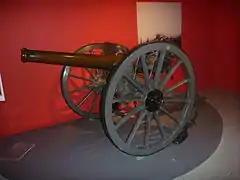9 cm Kanone C/73
The 9 cm Kanone C/73 was a field gun developed after the Franco-Prussian War and used by Germany before and during World War I.
| 9 cm Kanone C/73 | |
|---|---|
 A 9 cm Kanone C/73 at the Museo Histórico Militar de Valencia. | |
| Type | Field gun |
| Place of origin | German Empire |
| Service history | |
| In service | 1873-1922 |
| Used by | See users |
| Wars | See wars |
| Production history | |
| Designer | Krupp |
| Designed | 1873 |
| Manufacturer | Krupp |
| Produced | 1873-1891 |
| Variants | 9 cm K C/79 (bronze barrel) 9 cm K C/73-88 (light barrel) 9 cm K C/73-91 (nickel-steel)[1] |
| Specifications | |
| Mass | Travel: 2,515 kg (5,545 lb) Combat: 1,210 kg (2,670 lb) |
| Barrel length | 2.1 m (6 ft 11 in) L/24[2] |
| Shell | Separate-loading, bagged charges and projectiles |
| Shell weight | HE: 7.2 kg (15 lb 14 oz) Shrapnel: 8.1 kg (17 lb 14 oz) |
| Caliber | 88 mm (3.5 in) |
| Breech | Horizontal sliding-block |
| Recoil | None |
| Carriage | Box trail |
| Elevation | -15° to +16° |
| Traverse | None[2] |
| Rate of fire | 10 rpm |
| Muzzle velocity | 464–442 m/s (1,520–1,450 ft/s) |
| Effective firing range | 6.5 km (4 mi) |
| Maximum firing range | 7.1 km (4.4 mi)[2] |
History
After the Franco-Prussian War, the German Army began to study replacements for its existing C/61 steel breech-loaded cannons. Although the C/61 had outclassed its bronze muzzle-loaded French rivals during the war its Wahrendorff breech was unpopular with gun crews. The new gun designated the C/73 retained the same 88 mm (3.5 in) ammunition as the C/61 and was assigned to the field artillery regiments of the Army. The German and Austro-Hungarian Army during that period rounded up to the nearest centimeter.[3]
In addition to the German Army, C/73s also armed the Ottoman Empire and a number of the Balkan states. The Balkan states either bought them from Germany, built them under license or inherited Ottoman guns after they left the region. Although largely replaced by the German Army before the First World War, a combination of higher than expected losses and insufficient ammunition production led to the C/73 being brought out of reserve and issued as replacements to field artillery regiments. Some C/73s are believed to have been used by Turkey as late as 1922.[1]
Once adequate numbers of new field guns such as the 7.7 cm FK 16 were being produced obsolete types such as the 9 cm Kanone C/73 and captured guns such as the 76 mm divisional gun M1902 and Canon de 75 modèle 1897 were withdrawn from front-line service and issued to anti-aircraft units. At first, all of the combatants employed field guns on improvised anti-aircraft mounts, which were typically earthen embankments or scaffolds to get the muzzle pointed skyward. Later in the war, specialized anti-aircraft mounts were developed. In 1918 it was estimated that there were still 614 C/73s and C79s deployed in that role.[2]
Design
Although made of steel like its predecessor, the C/73 was of built-up construction with a central rifled tube, a reinforcing hoop from the trunnions to the breech and a larger propellant chamber for higher muzzle velocities and greater range. The C/73 featured a new breech, known as a cylindro-prismatic breech, which was a predecessor of Krupp's horizontal sliding-block, and the gun used separate-loading, bagged charges and projectiles.[3]
The C/73 had a box trail carriage built from bolted steel plates instead of wood. The C/73 did not have a recoil mechanism or a gun shield. For transport, the gun was attached to a limber for towing by a six-horse team. The limber also had seats for crew members plus ammunition and supplies. There were also seats attached to the axle of the gun carriage for the crew.[3]
In addition to the original steel barrel a hardened bronze barrel was introduced in 1879 and that gun was designated as the 9 cm Kanone C/79. A change from black powder to smokeless powder propellant was addressed during 1888 by adopting a new barrel with the designation C/73-88. Later, a new nickel-steel barrel was introduced in 1891 to address premature barrel explosions by shells filled with picric acid. These were given the designation C/73-91.[3]
Users
Wars
Photo Gallery
| Wikimedia Commons has media related to 9 cm Kanone C/73. |
 A C/73 with limber.
A C/73 with limber. A Spanish built bronze barrelled Modelo 1878.
A Spanish built bronze barrelled Modelo 1878. A Turkish gun converted to anti-aircraft use.
A Turkish gun converted to anti-aircraft use. The breech of an early Krupp gun.
The breech of an early Krupp gun.
References
- "9cm Kanone 1873 (/1891)". www.passioncompassion1418.com. Retrieved 21 September 2018.
- Fleischer, Wolfgang (February 2015). German artillery:1914-1918. Barnsley. pp. 19 & 92. ISBN 9781473823983. OCLC 893163385.
- Jäger, Herbert (2001). German artillery of World War One. Marlborough: Crowood Press. pp. 11–15. ISBN 1861264038. OCLC 50842313.
